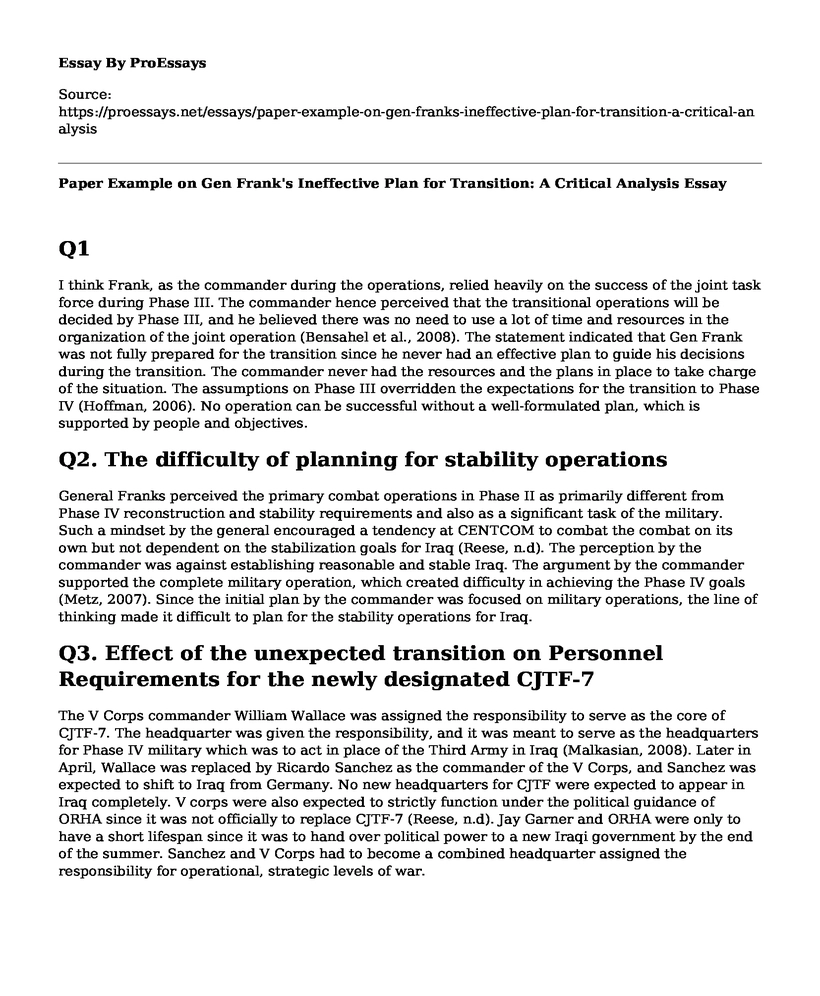Q1
I think Frank, as the commander during the operations, relied heavily on the success of the joint task force during Phase III. The commander hence perceived that the transitional operations will be decided by Phase III, and he believed there was no need to use a lot of time and resources in the organization of the joint operation (Bensahel et al., 2008). The statement indicated that Gen Frank was not fully prepared for the transition since he never had an effective plan to guide his decisions during the transition. The commander never had the resources and the plans in place to take charge of the situation. The assumptions on Phase III overridden the expectations for the transition to Phase IV (Hoffman, 2006). No operation can be successful without a well-formulated plan, which is supported by people and objectives.
Q2. The difficulty of planning for stability operations
General Franks perceived the primary combat operations in Phase II as primarily different from Phase IV reconstruction and stability requirements and also as a significant task of the military. Such a mindset by the general encouraged a tendency at CENTCOM to combat the combat on its own but not dependent on the stabilization goals for Iraq (Reese, n.d). The perception by the commander was against establishing reasonable and stable Iraq. The argument by the commander supported the complete military operation, which created difficulty in achieving the Phase IV goals (Metz, 2007). Since the initial plan by the commander was focused on military operations, the line of thinking made it difficult to plan for the stability operations for Iraq.
Q3. Effect of the unexpected transition on Personnel Requirements for the newly designated CJTF-7
The V Corps commander William Wallace was assigned the responsibility to serve as the core of CJTF-7. The headquarter was given the responsibility, and it was meant to serve as the headquarters for Phase IV military which was to act in place of the Third Army in Iraq (Malkasian, 2008). Later in April, Wallace was replaced by Ricardo Sanchez as the commander of the V Corps, and Sanchez was expected to shift to Iraq from Germany. No new headquarters for CJTF were expected to appear in Iraq completely. V corps were also expected to strictly function under the political guidance of ORHA since it was not officially to replace CJTF-7 (Reese, n.d). Jay Garner and ORHA were only to have a short lifespan since it was to hand over political power to a new Iraqi government by the end of the summer. Sanchez and V Corps had to become a combined headquarter assigned the responsibility for operational, strategic levels of war.
Q4. Recommendations to assist the commander during the transition to Phase IV
The commander should have ensured that the military operations have dominated an adversary. The forces should have provided security to the people and stability of Iraq through promoting cultural awareness among the military personnel (Metz, 2007). The commander should have focused on the expected outcome of the operations in Iraq but not the result of the major conflict. He should have established a desired political situation that could have signaled the completion of the war (Metz, 2007). The commander should have begun with Phase IV or develop sequenced plans by dispensing the phases so that he could not risk losing essential connections during the transitions into Phases.
References
Bensahel, N., Oliker, O., Crane, K., Richard Jr, R., & Gregg, H. S. (2008). After Saddam: Prewar planning and the occupation of Iraq. Rand Corporation. https://apps.dtic.mil/dtic/tr/fulltext/u2/a483265.pdf
Hoffman, B. (2006). Insurgency and counterinsurgency in Iraq. Studies in Conflict & Terrorism, 29(2), 103-121. https://apps.dtic.mil/dtic/tr/fulltext/u2/a426633.pdf
Malkasian, C. (2008). Counterinsurgency in Iraq. Counterinsurgency in Modern Warfare, 241-259.
Metz, S. (2007). Learning from Iraq: counterinsurgency in American strategy. Strategic Studies Institute, US Army War College. https://apps.dtic.mil/dtic/tr/fulltext/u2/a468470.pdf
Reese, D. P. W. T. R. The United States Army In Operation Iraqi Freedom, May 2003-January 2005: On Point II Transition To The New Campaign. https://www.globalsecurity.org/military/library/report/2006/ssi_metz.pdf
Cite this page
Paper Example on Gen Frank's Ineffective Plan for Transition: A Critical Analysis. (2023, May 08). Retrieved from https://proessays.net/essays/paper-example-on-gen-franks-ineffective-plan-for-transition-a-critical-analysis
If you are the original author of this essay and no longer wish to have it published on the ProEssays website, please click below to request its removal:
- Veterans Education Benefits Essay
- Gen. John "Jay" Raymond Speech Outline
- Essay Sample on Innovation and the Public Manager
- VHA Nurses' Beliefs & Training for Care of TBI Patients - Essay Sample
- Essay on Airpower: Influencing Behaviors, National Security, War
- Essay Sample on Drone Strikes: A Legal Controversy
- Honoring Our Veterans: Showing Gratitude for a Debt That Can Never Be Repaid - Essay Sample







